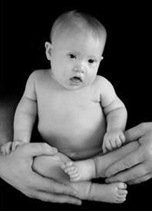Diagnosing Down Syndrome Babies and Infants

Learn about the best tests for diagnosing Down syndrome babies, such as amniocentesis, chorionic villus sampling, and blood testing that can be completed in the first and second trimesters of pregnancy.
Stressing about your child having a disorder when pregnant can be bad for the baby, so it’s important to remember that testing during the first trimester has about a 5% risk of showing a false positive.
I know many women choose not to have the test because of the risk of a false positive and the fact that they wouldn't choose to terminate the pregnancy regardless, so why be worried for the entire pregnancy.
How does diagnosing Down Syndrome occur?
A series of tests during regular prenatal visits are usually the primary way they are able to assess whether the child is at risk of having the disorder.
However, because there is a risk of obtaining a false positive it isn’t until the child is born that you are able know for sure whether your child will have Down syndrome chromosomes. In fact a friend of mine was told during pregnancy that her child tested positive only for the child to be born a healthy baby boy.
Testing for Down Syndrome During Pregnancy
Preliminary testing between week 11 and 20:
• Ultrasound - During an ultrasound the technician will do a nuchal translucency screening test by measuring a specific area on the back of the baby's neck. Abnormalities are noticed when more fluid than usual collects in this tissue.
• Blood Testing- Ultrasound results are reviewed with blood tests that measure levels of pregnancy-associated plasma protein-A (PAPP-A) and the hormone known as human chorionic gonadotropin (HCG). When there are abnormal levels of PAPP-A and HCG a problem may be indicated.
Further tests if there appear to be Down syndrome risks for the baby:
• Amniocentesis. This test is typically done after 15 weeks of gestation with a one in 200 risk of miscarriage. After inserting a needle into the mother’s uterus, a sample of the amniotic fluid is obtained and then used to analyze the chromosomes of the fetus and assist in diagnosing.
• Chorionic villus sampling (CVS). This test is typically done between the nine and 14 weeks gestation with a one in 100 risk of miscarriage. It involves taking cells from the mother's placenta in order to also analyze the fetal chromosomes.
• Percutaneous umbilical blood sampling (PUBS). This test is usually performed after 18 weeks gestation and has the greatest risk of miscarriage. It involves taking blood from a vein in the umbilical cord and examining it for chromosomal defects. Normally, this test is only done when the speed of diagnosing is crucial.
These tests are about 98 to 99 percent accurate in diagnosing Down syndrome.
Diagnosing Down Syndrome in Newborns:
After birth, a diagnosis is often based on physical characteristics. If your child displays many of the symptoms, then your doctor probably will likely request a test called a chromosomal karyotype to analyze your child's chromosomes before diagnosing. A diagnosis is officially made when there is an extra chromosome 21 present in all or some of the cells.
Additional Recommended Pages:
• Symptoms and Medical Conditions
Return Home from Diagnosing Down Syndrome Page
References
1. Mayo Clinic Staff. (2009). Down Syndrome. www.mayoclinic.com. 10-11-10.